For nearly 150 years, Texas A&M University students have answered their country’s call to service. And in answering that call, many Aggies made the ultimate sacrifice.
To honor them and their selfless service, Texas A&M has erected several memorials around its main campus to honor Aggies who served the United States during past wars and made the ultimate sacrifice. Memorials like the Memorial Student Center, Simpson Drill Field, Spirit Plaza and others reflect the university’s deep respect and reverence for these Aggies and their service.
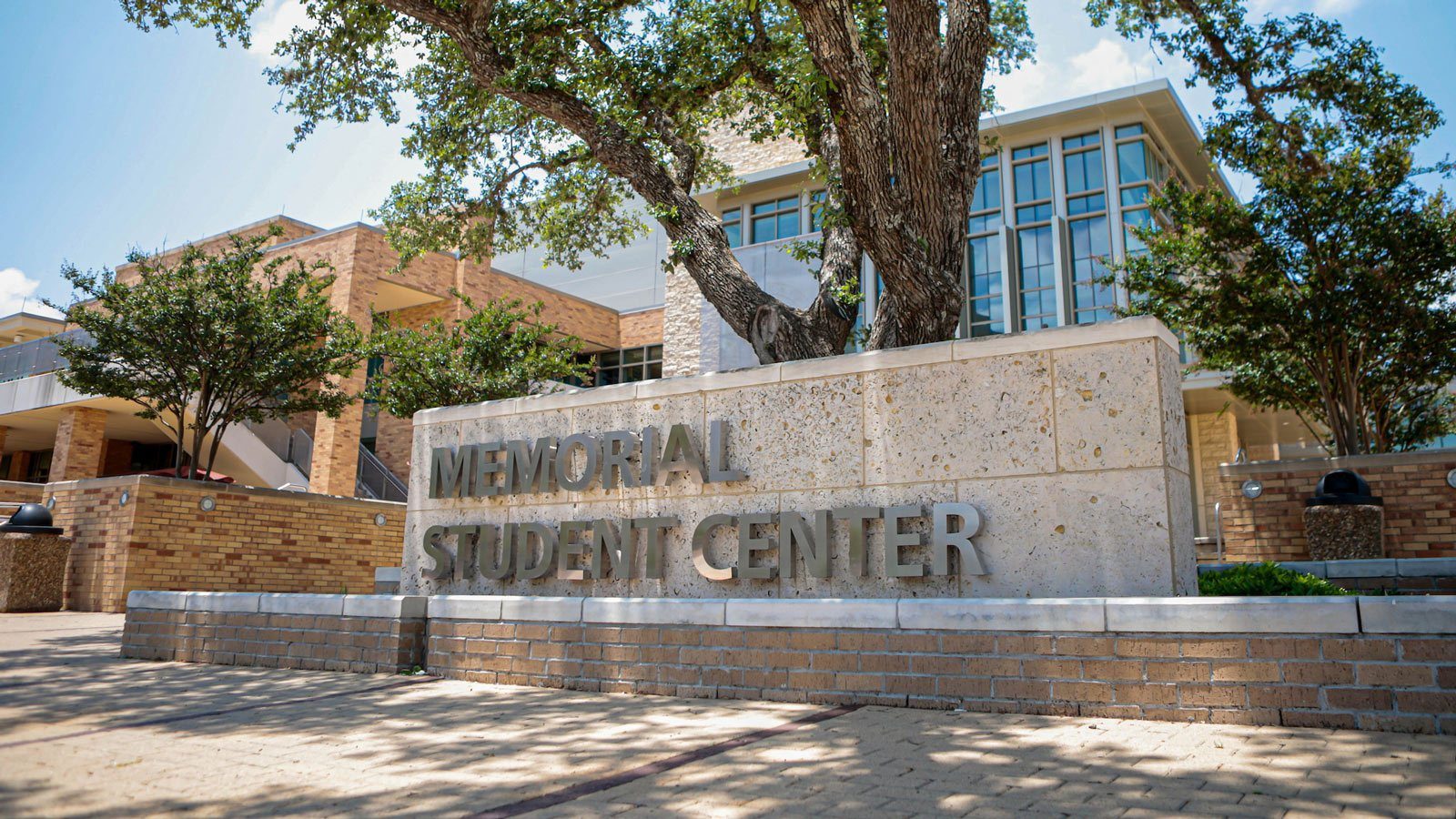
The Memorial Student Center honors all Aggies who lost their lives in service during World War I and World War II.
Memorial Student Center
One of the most recognizable and visited memorials on Texas A&M’s College Station campus is the Memorial Student Center, also known as the MSC. Dedicated on April 21, 1951, during Aggie Muster, the MSC honors all Aggies who lost their lives in service during World War I and World War II. After the Vietnam War, the MSC was rededicated to commemorate all Aggies, both past and future, who made the ultimate sacrifice for their country. Often referred to as “The Living Memorial,” the MSC serves as a place of remembrance and reflection. As such, all who enter the building are asked to remove their hats. Those walking outside are asked not to walk on the grass surrounding the building as a sign of respect to fallen Aggies.
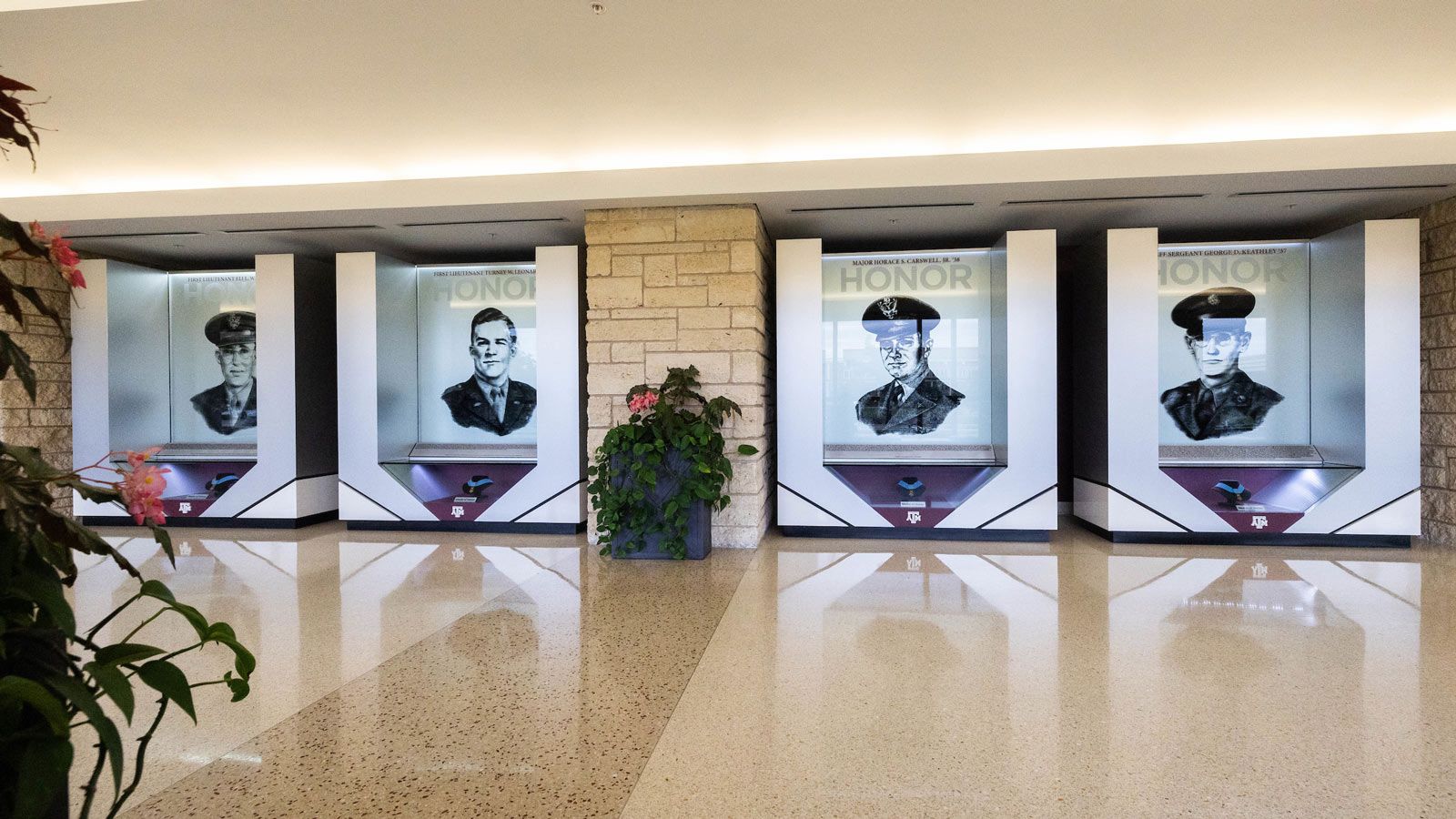
The Hall of Honor is dedicated to the eight Aggies who have been awarded the prestigious Medal of Honor for their extraordinary acts of bravery and service.
Hall of Honor
The Hall of Honor is dedicated to the eight Aggies who have been awarded the prestigious Medal of Honor for their extraordinary acts of bravery and service.
Located inside the MSC along the north side of the main floor across from Simpson Drill Field, the Hall of Honor was established as part of the MSC renovation completed between 2009 and 2012. It features the biographies, likenesses and replica medals of the eight Aggies who received the Congressional Medal of Honor.
The original Medals of Honor for several of these recipients are on display at the Sanders Corps Center.
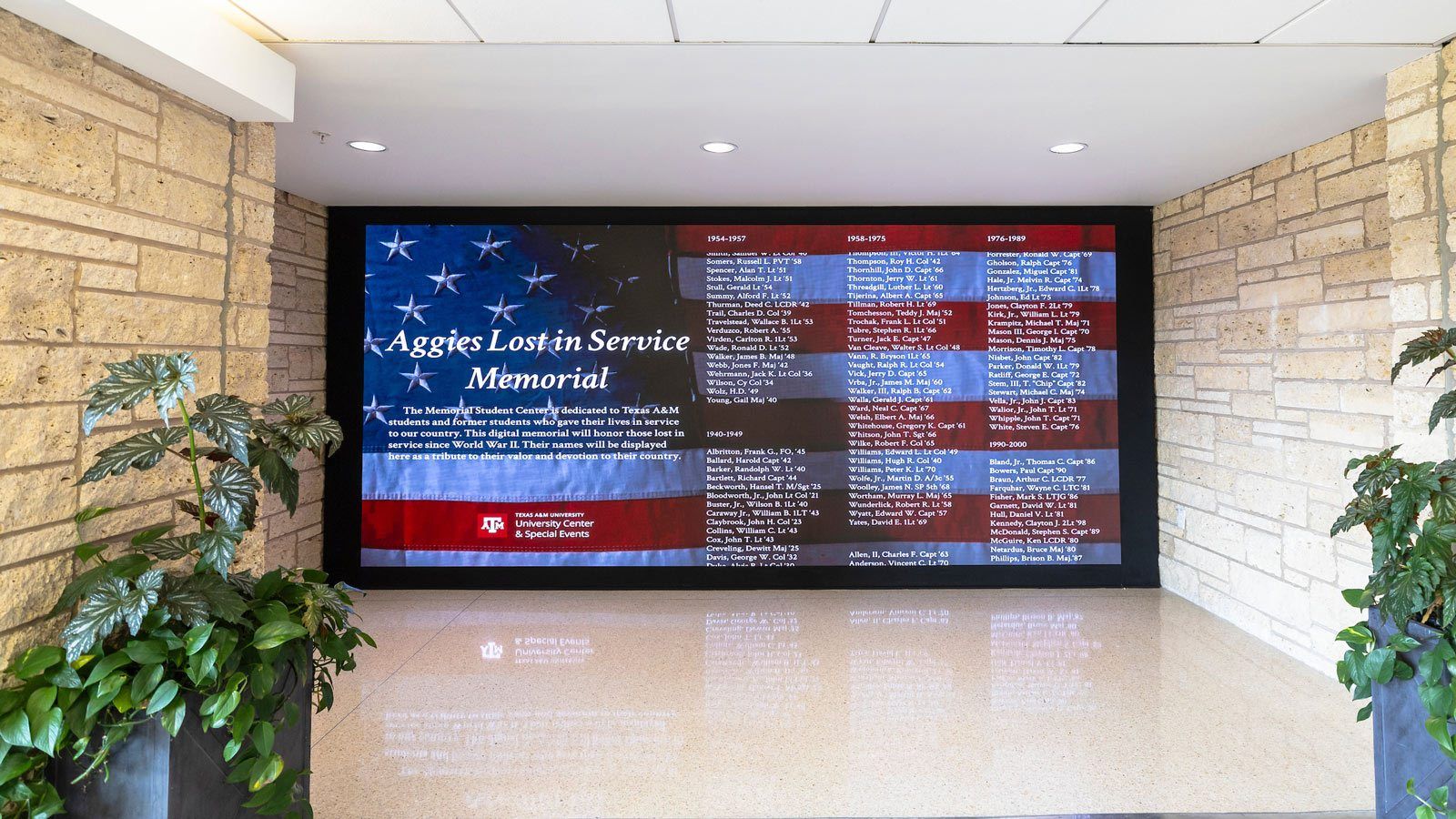
The Aggies Lost in Service Memorial lists the names of Aggies who have made the ultimate sacrifice since World War II.
Aggies Lost in Service Memorial
Inside the Hall of Honor entrance of the MSC stands the Aggies Lost in Service Memorial that lists the names of Aggies who have made the ultimate sacrifice since World War II. The illuminated, 17-foot-long display features a scrolling list of the names of Aggies who have died in military service. The list scrolls through twice during a 16-minute video that highlights the stories of some of these brave Aggies. The names featured on the wall are constantly being updated, and names can be submitted to University Center and Special Events for consideration.
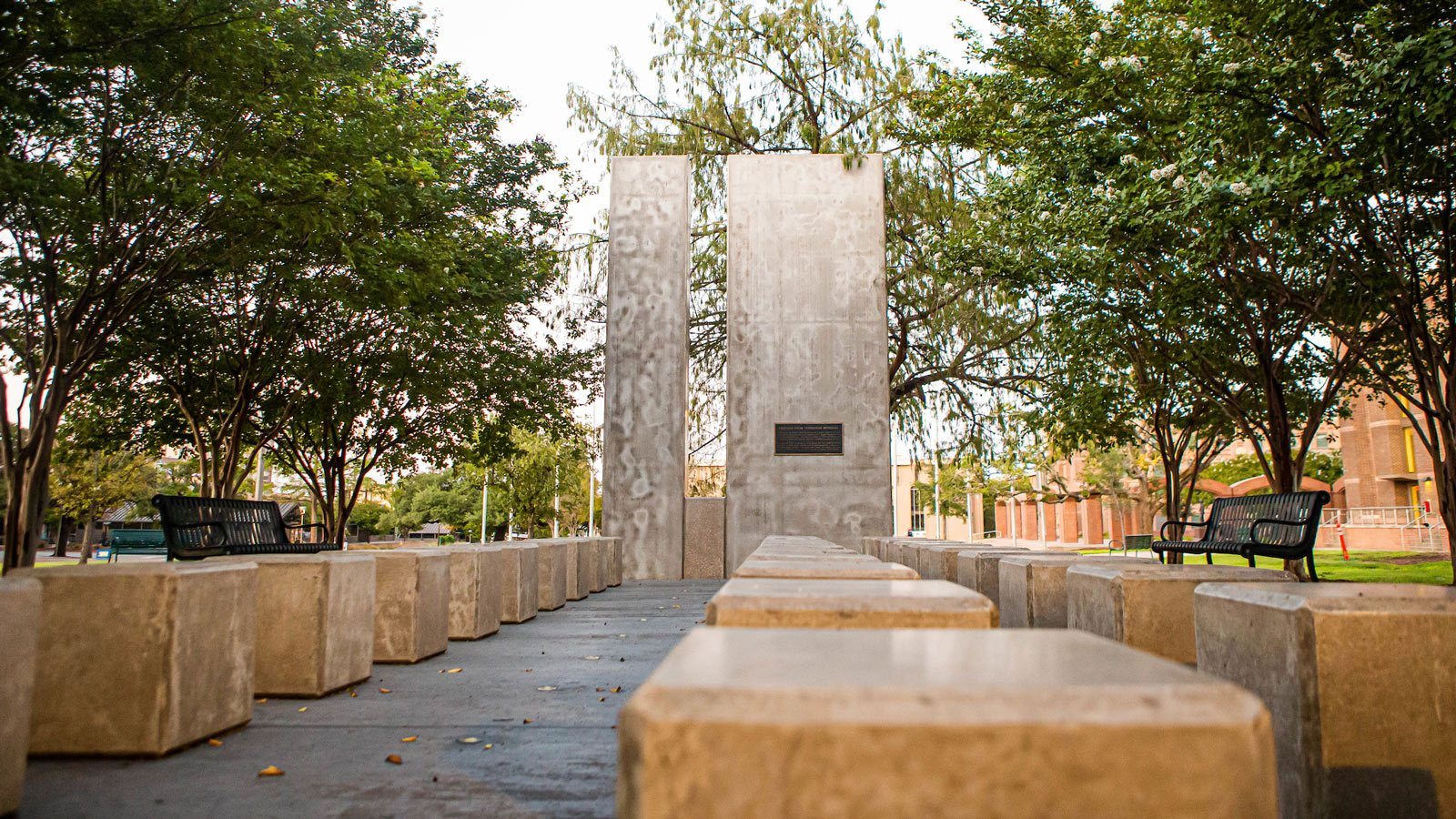
The Freedom From Terrorism Memorial honors the Aggies who made the ultimate sacrifice in the War on Terror.
Freedom From Terrorism Memorial
Unveiled in 2008, the Freedom From Terrorism Memorial honors the Aggies who made the ultimate sacrifice in the War on Terror. It stands as a poignant reminder of the lasting impact of the Sept. 11, 2001, attacks on our nation.
Situated in a highly visible and frequently visited area on campus, the memorial’s striking design is intentionally placed to interrupt the natural flow of pedestrian movement, encouraging pause and reflection. Visitors will find themselves surrounded by 12 trees, providing shade to benches that face the sculpture, fostering a peaceful and reflective atmosphere. The memorial’s central feature is a concrete wall, its largest section representing the strength, courage and liberty of America. A breach in the wall symbolizes the devastating effects of the 9/11 attacks and the War on Terror, with the rough texture beneath the gap reflecting the scars left on American society. The first row of concrete cubes represents the spirit of the 12th Man, while the second row is deliberately missing to signify the Aggies lost in service, with 12 lights in their place shining in tribute. The final two rows stand for the future generations of Aggies who will continue to serve and protect the country’s freedoms and values.
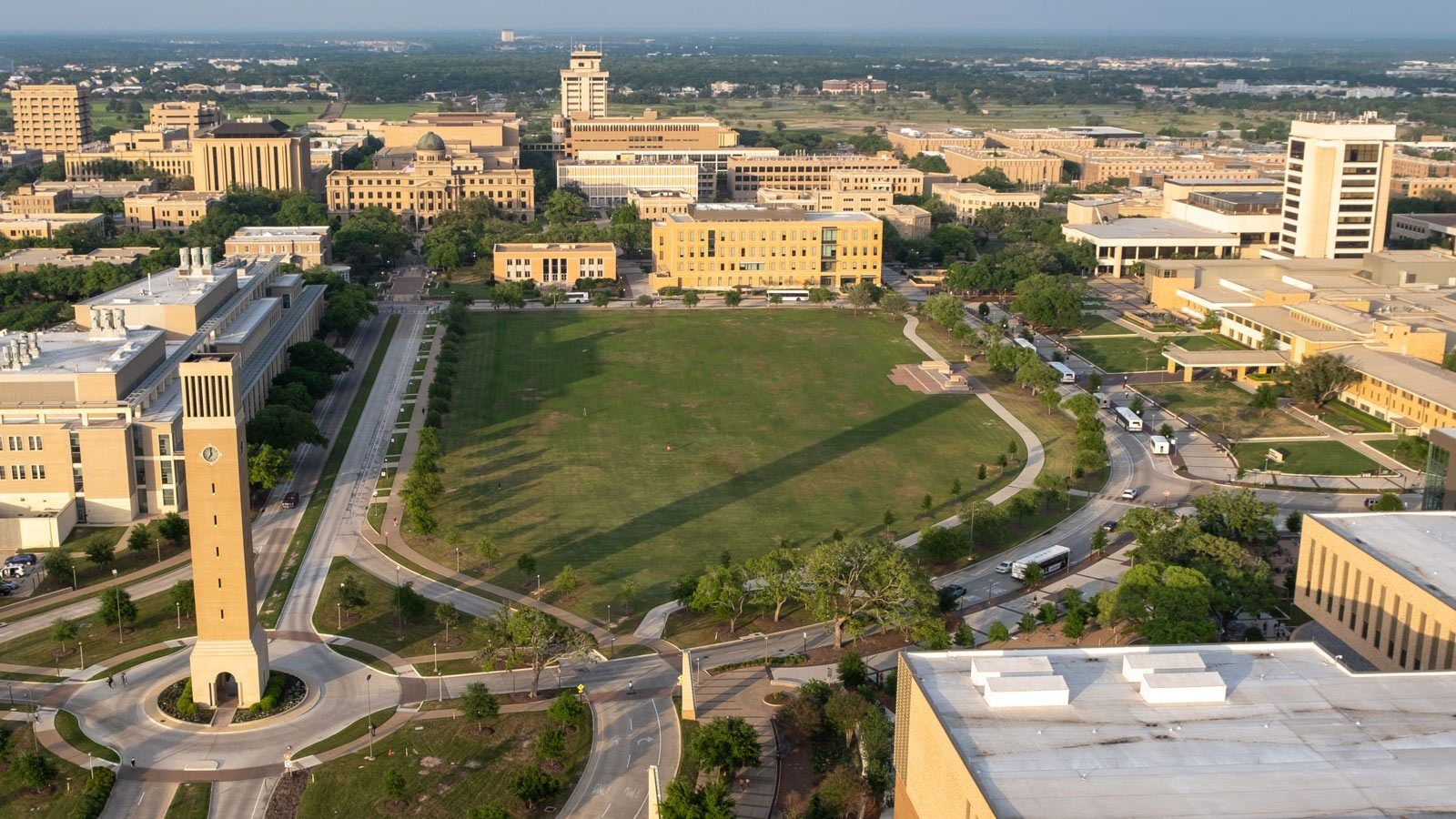
The trees surrounding Simpson Drill Field are dedicated to the Aggies who gave their lives in service during World War I.
Simpson Drill Field
Simpson Drill Field is named in honor of Lt. General Ormond R. Simpson ’36, a U.S. Marine Corps veteran who served in World War II, Korea and Vietnam. He held the position of vice president for student services and was the head of the School of Military Sciences until his retirement in 1985. The field, which dates back to the opening of the college in 1876, was originally used as the Corps of Cadets’ drill field and has hosted artillery and infantry exercises, practice maneuvers and served as the first football field until 1905. It was also the site of the Aggie Bonfire from 1909 to 1955 and has been the location for many final reviews and graduation ceremonies.
In 1919, Texas A&M’s Board of Directors decided to honor former students who died in service during World War I with a living memorial. On Feb. 23, 1920, 52 live oak trees were planted on the drill field, stretching from Old Main and Lamar Street to Hart Hall. Over time, construction led to the relocation of these trees, and they now stand around the drill field. At the base of each tree, plaques honor the fallen Aggies with their name, class year and details of their death. Later, three more names and memorials were added, bringing the total to 55. During the World War I Centennial, 15 additional Aggies were identified, and in January 2022, memorial trees and plaques were placed in their honor. Additionally, following the 1920 planting ceremony, a tree was planted to honor Asbury B. Davidson, a former vice president of the college and Texas lieutenant governor.

The Corps Plaza memorial honors those who gave their lives in service to the country, particularly during the Korean and Vietnam Wars.
Corps Plaza
Originally located in a meditation garden outside Duncan Dining Hall, the 10-by-5-foot concrete memorial was dedicated by the Aggie Class of 1969 during a special Muster-like ceremony. The memorial was created to honor those who gave their lives in service to the country, particularly during the Korean and Vietnam Wars. Designed with space left to include the names of future fallen Aggies, it was a lasting tribute to the sacrifices of those who serve.
In 1987, during renovations to Duncan Dining Hall, the memorial was relocated to a more prominent position on the north side of the Corps Plaza. Now situated at the top of a shallow, three-step dais and surrounded by 12 flags representing the 12th Man, the reconditioned structure displays the names of over 370 fallen Aggies, each honored with an embossed bronze plaque. This new location ensures the memorial is more visible and accessible, allowing it to continue its role in honoring the Aggies who made the ultimate sacrifice in defense of their country.
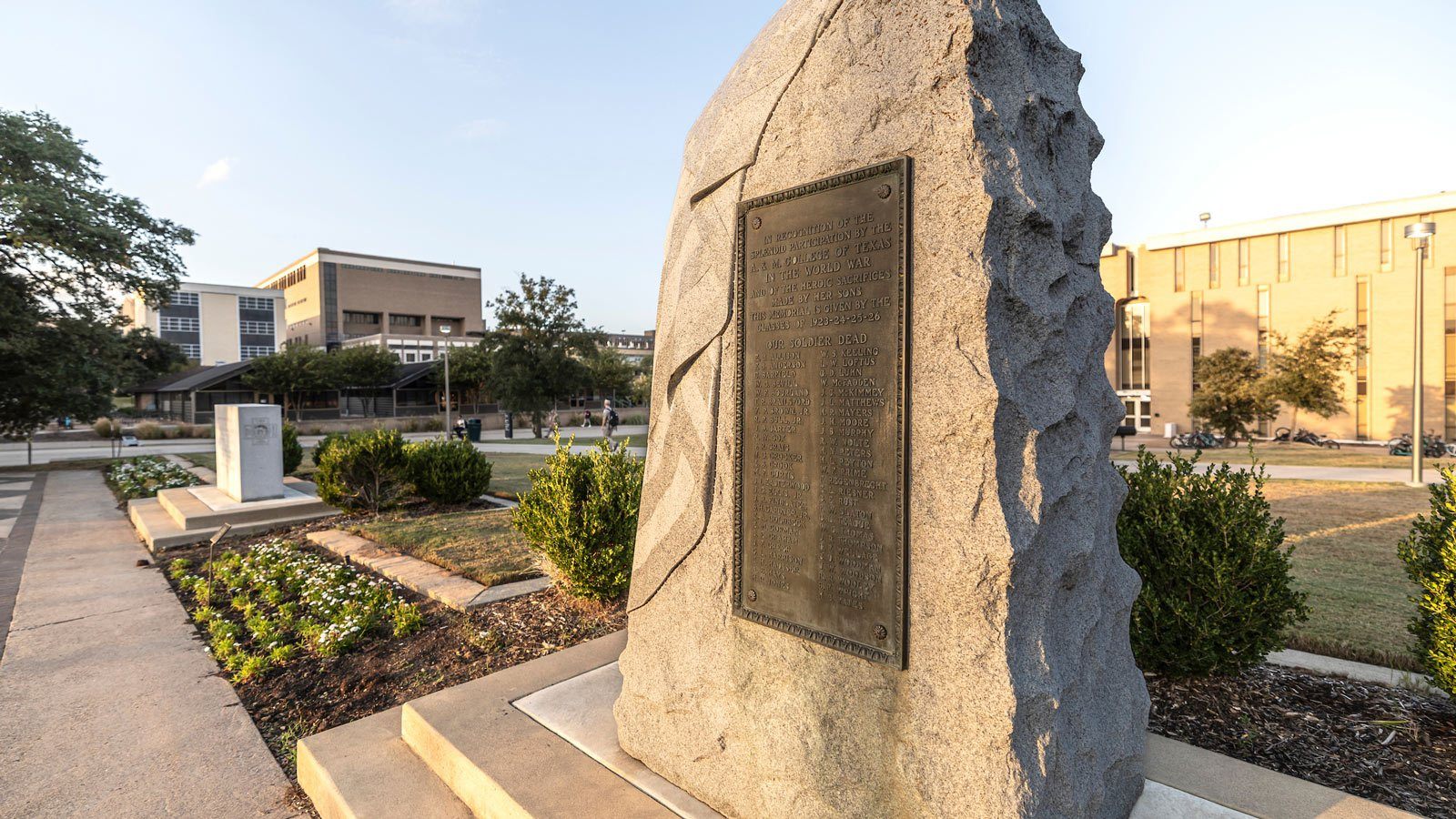
The World War I Memorial bears the names of 52 Aggies who made the ultimate sacrifice during World War I.
World War I Memorial
The memorial, dedicated by Governor Pat M. Neff on April 21, 1924, was a gift from the Classes of 1923, 1924, 1925 and 1926. Originally situated in front of Guion Hall, the nearly 9-foot-tall, 9-ton solid Vermont granite structure now stands in the Corps Plaza. Shaped like a headstone, the monument retains its rough, natural form, with an American flag carving draping the top left corner of the stone, evoking the image of a flag that covers the coffin of a fallen soldier. In the center of the memorial, a bronze tablet bears the names of 52 Aggies who made the ultimate sacrifice during World War I.
This memorial is part of a broader effort to honor the Aggies who lost their lives in World War I, with other tributes, including the flags over Kyle Field and the live oak trees surrounding Simpson Drill Field. Initially, 52 names were listed on the memorial, thought to represent the total number of Aggies who died in the war. However, as research continued, the number was updated to 55. During the World War I Centennial, University Archivist Greg Bailey, along with former students Bill Page ’80 and John P. Blair ’83, identified an additional 15 Aggies, bringing the total to 70. Due to Texas State Preservation laws, the memorial itself could not be updated to reflect these new names, but additional memorial trees were planted around Simpson Drill Field to honor the fallen.
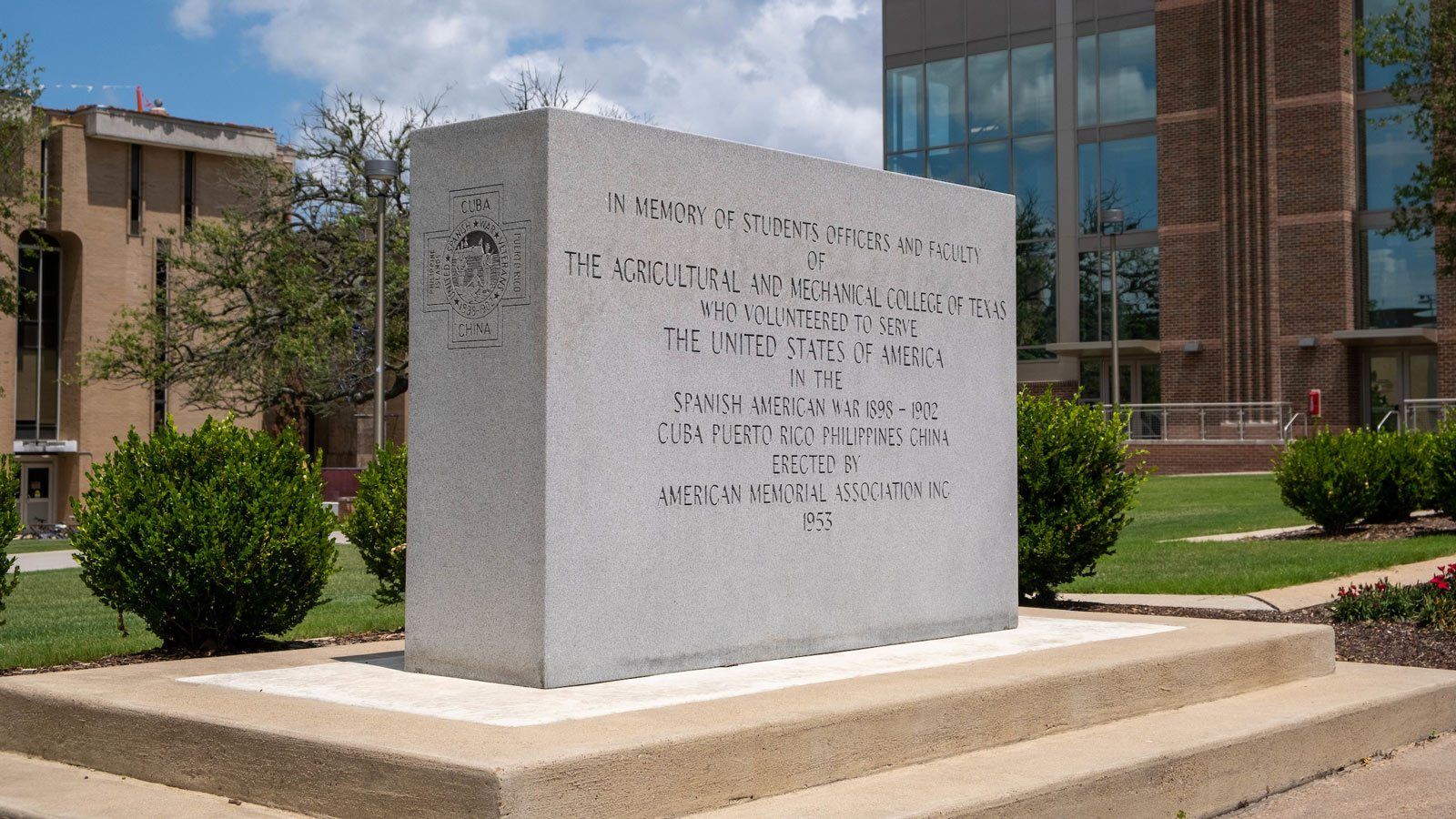
The Spanish-American War Memorial honors the Texas A&M student officers and faculty who volunteered to serve in the Spanish-American War.
Spanish-American War Memorial
The Spanish-American War Memorial, erected in 1953, stands as a tribute to the Texas A&M student officers and faculty who volunteered to serve in the Spanish-American War, which took place from 1898 to 1902. The memorial honors their courage and commitment during a pivotal time in U.S. history, recognizing the contributions of those who answered the call to serve their country.
Designed to be simple and understated, the memorial consists of a 6-foot-long grey granite structure, resembling a headstone, located on the north side of the Corps Plaza. Its minimalist design reflects the solemn nature of the tribute. The cross and detailed seals on either side of the memorial symbolize religious reverence and further emphasize the significance of those being honored, offering a visual representation of their sacrifice and service.
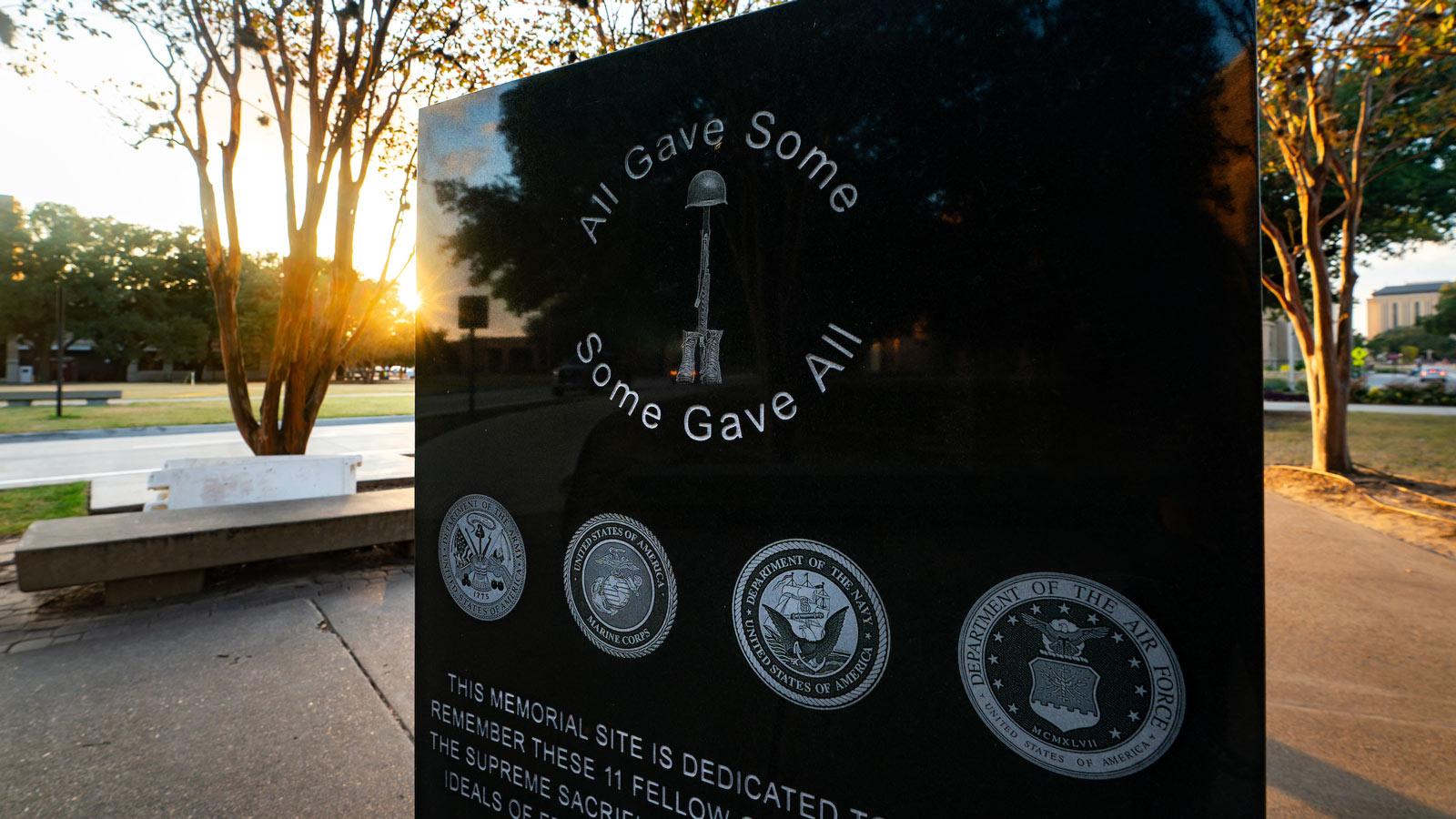
The Class of ’69 Vietnam War Memorial honors the 11 Aggies from the Class of 1969 who lost their lives in service during the Vietnam War.
Class of ’69 Vietnam War Memorial
The Class of ’69 Vietnam War Memorial, dedicated in 1996, honors the 11 Aggies from the Class of 1969 who lost their lives in service during the Vietnam War. Situated at the intersection of Joe Routt Boulevard and Coke Street, this 3-foot-tall black granite prism serves as a lasting tribute to their sacrifice. The memorial’s slanted top is etched with an American flag and features a bronze Texas A&M seal, while the front panels list each fallen Aggie’s name, branch of service, hometown and date of death. On the back, a dedication from the Class of 1969 expresses their deep remembrance of their comrades. The memorial is surrounded by six benches and 11 crepe myrtles, symbolizing the ongoing legacy of the 11 men who were lost.

